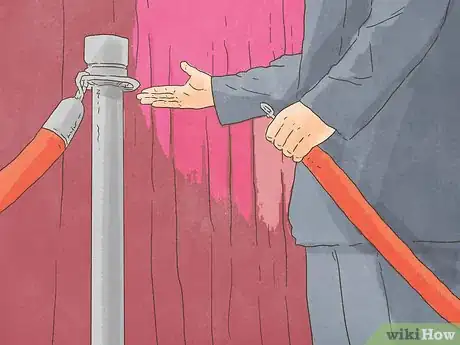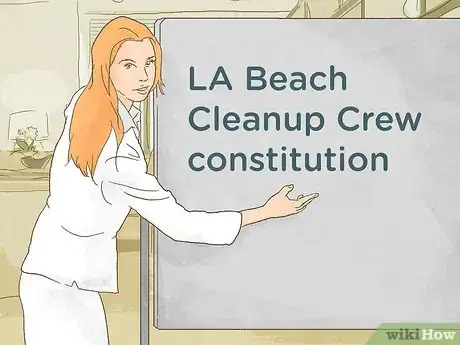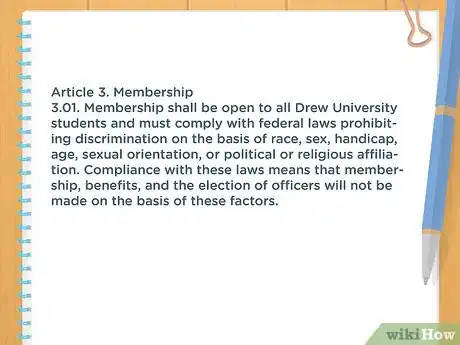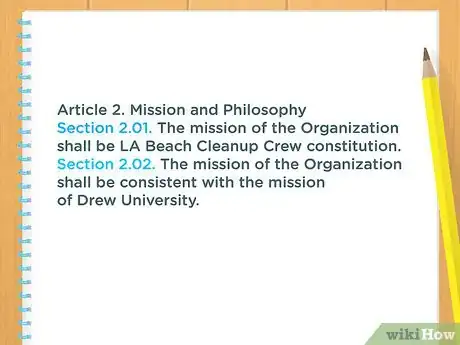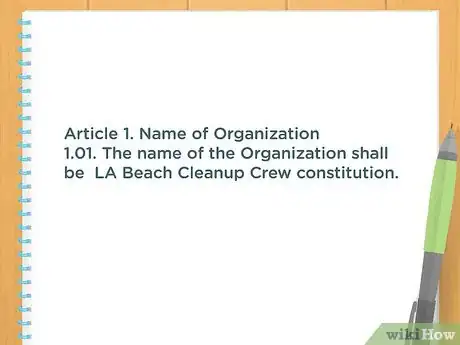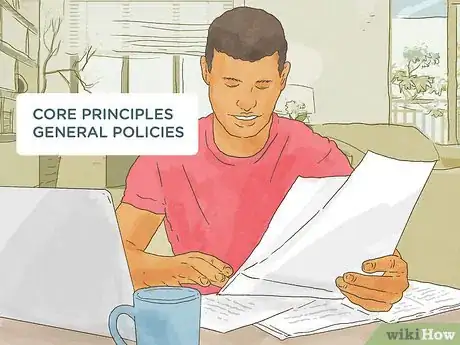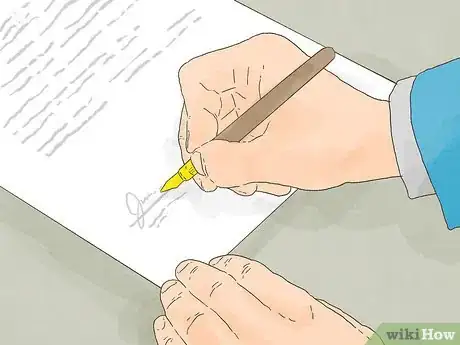This article was co-authored by wikiHow Staff. Our trained team of editors and researchers validate articles for accuracy and comprehensiveness. wikiHow's Content Management Team carefully monitors the work from our editorial staff to ensure that each article is backed by trusted research and meets our high quality standards.
wikiHow marks an article as reader-approved once it receives enough positive feedback. In this case, 91% of readers who voted found the article helpful, earning it our reader-approved status.
This article has been viewed 151,036 times.
Learn more...
A constitution is a set of rules for running a club. It provides guidelines for conflict resolution and a framework for action so that your club can accomplish its goals.[1] To write your own club constitution, you’ll need to meet with your club to discuss your club’s principles and and policies. If your club is affiliated with an institution, be sure check with them for any guidelines you'll need to follow. Once you and the other members have agreed on a clear vision, it’s time to start writing and implementing your constitution!
Steps
Preparing to Discuss your Constitution
-
1Set up a time to meet with your club. Try to find a time when all or most club members can meet. In this meeting, you should discuss the different elements that your constitution will address, including your club’s name, mission, membership requirements, and officers.
- The next section will provide more information on these elements.
-
2Assign note takers. Have two club members take notes during the meeting. That way, you’ll have a summary of everything that was discussed, and the writing process will be easier![2]
- It’s best to have two or more members take notes. You’ll get a more comprehensive summary of the meeting, and you’ll be less likely to miss something important.
Advertisement -
3Check with your institution for requirements. If your club is affiliated with an institution or community, such as a school or university, that institution may have specific guidelines and requirements for your constitution. Talk to your administrators so you know the key points to discuss in your meeting.[3]
- Many universities will provide a template for you to follow.
- Some institutions require that clubs adhere to set membership policies.
Discussing Your Constitution
-
1Pick a club name. Your club’s name is important. This is the title that will represent your club in your community and possibly beyond. Pick a title that reflects your club’s purpose and core activities. If your club cleans up beaches in LA, you might name it "The LA Beach Cleanup Crew."[4]
- Consider if you want your club’s name to be fun and catchy, or more formal.
-
2Define your club’s purpose. Every club was founded for a reason. Maybe your club aims to combat food insecurity in your hometown, or teach members about sports analytics. In your meeting, talk about your club’s long term goals and how you will accomplish them.[5]
- Try to answer the following questions: Where are will your club perform its work? Who benefits from your club’s work? In what way do they benefit?
- This is the most important part of the constitution, so make sure everyone is on the same page.
-
3Decide on membership policies. Discuss who can be a member of your club, and outline members’ privileges and responsibilities. Don’t forget to address the conditions under which membership can be revoked.[6]
- This is also the time to decide if you will have a membership fee. If so, how much will it be, and how often will members have to pay?
- Members might be anyone who pays dues, anyone who attends meetings, or anyone who participates in the club’s activities.
-
4Assign officers. Your club should have some sort of leadership structure, and often, this comes in the form of officers. Make a list of the officer positions you want in your club. Discuss officer responsibilities and rules for appointing, removing, and replacing officers.
- Common officer positions include President, Vice President, Secretary, and Treasurer.
- When writing your constitution, use the officer position title rather than the current officer's name. After all, officers will come and go throughout the club’s life.
-
5Decide if you want committees. You can also have committees within your group, if you’d like. Committees are in charge of running your club or specific projects within your club. Talk about how committees will be formed, which committees will be formed, the duties of each committee, and the processes for selecting and removing committee members and officers.
- Committees usually have a Chair, Secretary, and Treasurer.[7]
-
6Discuss meeting details. Discuss how often meetings will take place and how meetings will be scheduled. You may want to hold extra meetings for committees or officers only. Discuss how often these will be held.[8]
- You can also include some information about meeting procedures in your constitution. Think about how decisions will be made. If you want to make decisions by voting, provide a brief description of the voting criteria.
-
7Talk about finances. You may want to include a section about finances in your constitution. Talk about the procedures for opening and maintaining a club bank account, if you need one. Discuss how often finances will be reported, and who will keep a record of the club’s transactions (this is usually the Treasurer).
- Don’t forget to include a statement about how club funds will be spent. Generally, club money should only be spent on club materials and activities.
-
8Decide how the constitution can be changed. In the course of your club’s life, members may want to make changes to the constitution. These changes are called amendments.Your constitution should contain rules for proposing and implementing amendments.
- You might have all club members vote to ratify a change, or only the officers. Requiring the vote of two-thirds of club members is the norm.[9]
- If you have bylaws, a more flexible document that outlines the daily functioning of your club, your constitution should provide rules for amending the bylaws as well.
Formatting and Writing Your Constitution
-
1Divide your constitution into articles. The broad sections of your constitution are called articles. You should have articles for major categories like your club’s name, purpose, membership policies, officers, committees, meetings, finances, and amendment procedures. Generally, your club’s name and purpose should be the first two articles.[10]
- Feel free to add additional articles. For example, if members of your club are paying dues, then you could include a separate article for dues, if you want. However, you could also place dues under the membership article.
- Label articles by number and category. For example, your first article should be titled “Article 1. Name.”
- If your club is affiliated with an institution, refer to their constitution guidelines. Often, they require specific articles.
-
2Divide each article into sections. These sections address different aspects of the broader article category. The text of your constitution goes in the sections.[11]
- For example, in your article about officers, you might want to include sections about different officer titles, the responsibilities of each officer, the election process, and officer eligibility requirements.
- Write a sentence or two for each section.
- Label sections by number. For example, the first section in any article would be labeled “Section 1.”
-
3Use clear and concise language. Clarity is key when writing a constitution. Keep your language simple, professional, and to-the-point.[12]
- For example, when writing about your club’s name, opt for a simple sentence like, “The name of the club will be The Youth Rangers.”
-
4Make your guidelines comprehensive, but not overly specific. Your constitution should contain the core principles of your organization and its general policies. Try to find a balance between comprehensive guidance and administrative freedom. Things can get complicated if it’s too specific. More flexible documents generally work better.[13]
- For example, you should include rules about meeting frequency in your constitution, but not about meeting time or location. Those things will likely change based on members’ schedules and space availability.
-
5Write a draft. You should select a couple club members to write your constitution based on notes taken during your discussion. Pick members who are good writers. Remember, clarity is key![14]
- Look at various sample constitutions to guide you. You can find tons of them online.
- If your club is affiliated with an institution, they may provide you with a sample constitution.
Adopting your Constitution
-
1Review the finished constitution with your group. Call a meeting, and have everyone in your group look over the constitution. The majority of your group should accept the constitution. If this is not the case, you should make some edits based on member feedback.[15]
- If your constitution wasn’t accepted the first time, you’ll need to call another meeting after making edits to get it approved.
-
2Sign and date the constitution. Once the constitution has been accepted, have at least two club members sign and date it. If your club has officers, it’s a good idea to have two of them do this. [16]
- Signing makes the constitution valid.
-
3Distribute copies. Make sure every club member has a copy of the constitution. Digital copies are best--they save paper, and won’t become lost or crumpled like paper copies.[17]
- Don’t forget to file your constitution away in a safe location! Again, a digital file is best.
Community Q&A
-
QuestionCan a club rule be altered in retrospect?
 Community AnswerAbsolutely. Just bring it up at the club meeting and have a vote on it.
Community AnswerAbsolutely. Just bring it up at the club meeting and have a vote on it. -
QuestionCan a club rule be changed in retrospect?
 Community AnswerAbsolutely. Just bring it up at the club meeting and have an election about it.
Community AnswerAbsolutely. Just bring it up at the club meeting and have an election about it. -
QuestionThe president of my club is being rude, but she'll kick me out if I say anything. What should I do?
 Community AnswerTry having a private conversation with other members to see if they feel the same way. If enough members feel the president is being unfair, bring up your feelings together in a meeting. Also, be sure to check your club's constitution to see the procedures for removing officers. If your president repeatedly refuses to listen to feedback from club members, you may be able to remove her from her position.
Community AnswerTry having a private conversation with other members to see if they feel the same way. If enough members feel the president is being unfair, bring up your feelings together in a meeting. Also, be sure to check your club's constitution to see the procedures for removing officers. If your president repeatedly refuses to listen to feedback from club members, you may be able to remove her from her position.
Warnings
- Favoritism should NOT come before fairness.⧼thumbs_response⧽
- Do NOT make incredibly strict rules or brutal or unreasonable punishments. The point of a club is to have fun, not dictate the members' every breath. Nobody wants to be in a club that is no fun because they can't do anything without breaking a rule.⧼thumbs_response⧽
References
- ↑ http://www.resourcecentre.org.uk/information/constitutions/
- ↑ http://www.resourcecentre.org.uk/information/constitutions/
- ↑ https://www.cc-seas.columbia.edu/studentlife/groupres/newgroups/constitutions
- ↑ http://www.resourcecentre.org.uk/information/constitutions/
- ↑ http://www.resourcecentre.org.uk/information/constitutions/
- ↑ https://www.cc-seas.columbia.edu/studentlife/groupres/newgroups/constitutions
- ↑ http://www.resourcecentre.org.uk/information/constitutions/
- ↑ https://www.cc-seas.columbia.edu/studentlife/groupres/newgroups/constitutions
- ↑ https://www.cc-seas.columbia.edu/studentlife/groupres/newgroups/constitutions
- ↑ https://www.drew.edu/StudentActivities/information-on-starting-a-new-club/sample-club-constitution
- ↑ https://www.drew.edu/StudentActivities/information-on-starting-a-new-club/sample-club-constitution
- ↑ https://www.drew.edu/StudentActivities/information-on-starting-a-new-club/sample-club-constitution
- ↑ https://www.cc-seas.columbia.edu/studentlife/groupres/newgroups/constitutions
- ↑ http://www.resourcecentre.org.uk/information/constitutions/
- ↑ http://www.resourcecentre.org.uk/information/constitutions/
- ↑ http://www.resourcecentre.org.uk/information/constitutions/
- ↑ http://www.resourcecentre.org.uk/information/constitutions/
About This Article
To write a constitution for a club, start by defining your club's purpose, its long term goals, and how you will accomplish them. Next, decide on the membership policies, privileges, and responsibilities. As you formalize your club, create a leadership structure by assigning a President, Secretary, and Treasurer. Then, write your constitution by dividing this information into articles, then breaking down the articles into sections. To learn how to format and adopt your constitution, keep reading!





